“Chebukati is back!” Someone shouted at the other end of the newsroom.
“Chebukati is walking back to the podium where DP William Ruto and Rigathi Gachagua are seated!” Another voice added. At that time, I couldn’t place the voice with the name as there was a mixture of confusion, adrenaline rush and anxiety at the same time.
“Is the article on Ruto being announced winner ready?” an editor in the space asks. “Don’t publish that article until Chebukati declares him. This Bomas of Kenya drama may escalate and we are left with eggs in our faces,” he adds to the writer.
All focus on that day, Monday, August 15, was on the Independent Electoral and Boundaries Commission (IEBC) chairperson, Wafula Chebukati, who was set to announce Deputy President William Ruto of the United Democratic Alliance (UDA) as president-elect.
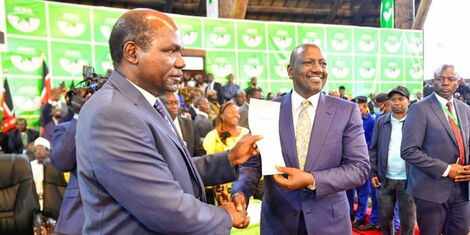
IEBC Chairman Wafula Chebukati presents President-elect William Ruto his election certificate at the Bomas of Kenya on Monday, August 15, 2022.
William Ruto
Ruto was contesting against former Prime Minister, Raila Odinga, of the Azimio La Umoja coalition, Roots Party’s George Wajackoyah and Agano Party’s Mwaure Waihiga. IEBC’s announcement was postponed from 3pm to 5pm and 6pm.
Chebukati had promised the nation that he would declare the winner in broad daylight. Time was ticking. Raila Odinga had not yet arrived at Bomas. His chief agent, Saitabao Kanchory, had just refuted the election results (which no one else was privy to).
At IEBC, four other commissioners dissented claiming that Chebukati was acting dictatorially. The four, vice chairperson Juliana Cherera, Francis Wanderi, Justus Nyang’aya and Irene Masit, were holding a parallel news conference to Chebukati’s.
The ticking of keyboards, the swift decision-making, and calls to the video team in the field to send footage for social media posts; it was a flurry of events.
But that was the climax of the drama. When did the script begin? Here is what happened behind the scenes in the newsroom at Kenyans.co.ke as narrated by John Mbati, sub-editor, Kenyans.co.ke.
Kenyans.co.ke was ranked among the most read online news outlets in Kenya by Reuters, an international news organisation, in June 2022. Starting in 2015, it has grown from a start-up media house to a leader in the digital space, with an audience reach running into millions of users and a dedicated team of over 30 journalists.
Election Preparation and Planning
In early April 2022, the preparations for election coverage commenced. This has always been one of the busiest periods in any newsroom.
From working extra hours and undertaking extra duties to spending more time on your laptop or running up and down in the field. A period of news fatigue where you get exhausted with the political news cycle and endless coverage of politicians.
As Kenyans anxiously waited for Tuesday, August 9, to cast their votes, journalists at Kenyans.co.ke were ready to ensure that all the news of the day was executed with military-style precision.
From the party primaries in April 2022 to the nominations a month later to the official campaign period commencing in June 2022 to three days before the election, on August 6, 2022, all was set for the big day.
Therefore, it is arguable that the elections in Kenya start from April to November if you factor in the petitions and repeat elections. Eight months of election coverage.
Through voting, Kenyans exercise not only their democratic right but also voice their opinions and usher in a new government. Elections are thus the centrepiece of democracy and the media’s role is to report thoroughly and accurately as it has the capacity to empower the electorate.
Thus, preparations started in April, from applying for the Media Council of Kenya (MCK) accreditation for the new staff to the Independent Electoral and Boundaries Commission (IEBC) media badges, election coverage training, fact-checking, and fact-checking workshops and covering the presidential debates.
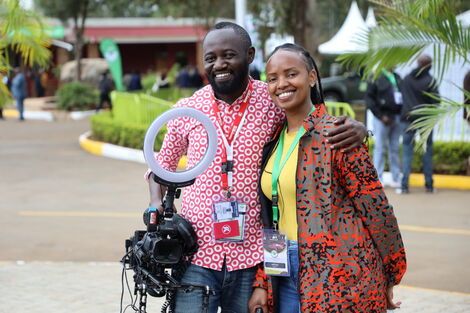
Kenyans.co.ke videographers, Musa Chahare and Ivy Nyawira at the Bomas of Kenya on Sunday, August 14, 2022
Kenyans.co.ke
Election Day
On Tuesday, August 2, the HR calls for a staff meeting, one week to the polls – August 9 – to discuss election shifts.
The HR bases her decision on the location of polling stations. Divides the team into two, those who ought to travel to vote and those casting their ballots in Nairobi metropolis – Kiambu, Nairobi, Machakos, and Kajiado counties.
We are also allowed to work remotely on the election date. The travelling team works from 6am to 2pm, with those within Nairobi checking in from 2pm to 11pm. The duty roster is rotated from Wednesday with the travelling team taking the night shift.
The video and social media departments also share their schedules, with a number sent to the field and the national tallying centre, Bomas of Kenya.
Note that for this election, the majority of media houses – us included – deviated from reporting on violence. The media sets an agenda and during the tense election period, it is easy to fuel chaos and incite the mass.
IEBC chair, Wafula Chebukati, says that the Commission’s portal is accessible to the media and the public for the first time in Kenya’s election. The decision stemmed from the 2017 Supreme Court ruling that nullified that year’s General Election.
The Commission thus wanted to run a free, fair and transparent election.
“The media can now tally their own results. The tallies across the media houses vary, and we appreciate that this may be so because each media house is accessing the public portal of the results forms at different times and each is using its own criteria and sequencing among other factors – including perhaps different amounts of resources deployed.
“The final announcement and declaration of the results will be done by the National Returning Officer (Chebukati) here at Bomas. At the end of the tallying, they will be harmonised and will look similar because the results are from the same source. There should be no panic about the difference we are seeing on the media screens,” Chebukati explained after a public uproar.
We were also tallying our own results on our page, via Flourish – a Data Visualization and Storytelling application. This was one of the most hectic exercises during the election. Downloading over 46,000 Forms 34A uploaded on the IEBC portal.
However, just like other local and media houses, we also hit a snag with the tallying after Forms 34B started streaming in. Forms 34A are for the polling stations, and 34B are for the 291 constituencies.
Data in Forms 34A have to tally with 34B which then translates to Form 34C used to declare the President-elect.
For a few days, there are teams that work more than eight hours to cross-check the data till late at night, precisely 2am and 3am.
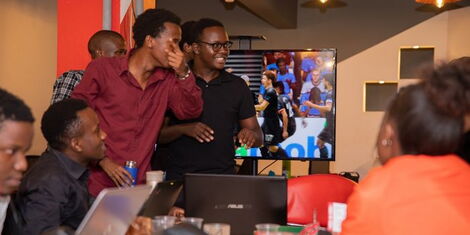
Kenyans.co.ke journalists inside the newsroom
Kenyans.co.ke
Content Development
As other media houses focused on the polling stations, the voter apathy, the mood in the country and the IEBC preparations, Kenyans.co.ke gave a 360 election coverage.
Traditional news coverage prevents the user from gratifying their needs. In recent years, digital transformation has diversified content which no longer relies on Content Management Systems but also on website analytics.
Thus, content creators have to cover all phases of the content marketing lifecycle including planning, measurement, and optimization. Content is also driven by the behaviour and needs of the user.
In layman’s terms, you think like a reader and feed him what he is looking for. Kenyans.co.ke, therefore, focused on explainers, debunking data in the simplest way possible. You ought to tweak your date to your own benefit.
This explains the origin of stories like Results for Uhuru, Mudavadi, Wetangula and Karua Polling Stations as the audience was searching for stories outside the box.
Other article include:
FACT CHECK :Does Juliana Cherera’s 0.01% Amount to 142,000 Votes?
IEBC Quorum: Did Chebukati Err to Announce Presidential Results After 4 Commissioners Protested?
Maina Kiai Case: What the Court Said on Tallying & Announcing Presidential Results
What the Court Ruled on IEBC Quorum During BBI
Our stories were, therefore, four-fold, from story generation to sourcing and reporting, graphics and art to follow-ups. We would break one press conference into three or four stand-alone articles to allow the reader to accommodate as much information.
The four-fold is complemented with social media posts, from engagements to quotes, polls and push notifications to video interviews.
The Aftermath
“Apparently, I wasn’t supposed to take these videos of party agents at Bomas of Kenya… oops! Nmetolewa mbio na GSU,” Ivy Nyawira, our video team coordinator at the national tallying centre laments.
It is Thursday, August 11, two days after the polls when the drama begins.
Bomas of Kenya is turning into a circus with politicians from two differing factions, Kenya Kwanza and Azimio La Umoja, clashing. The nation is anxious. On the same day, IEBC started streaming its data on a live feed.
By then, media houses had momentarily stopped their tallying owing to various reasons. From being overwhelmed by the data to confusion in IEBC verifying its Forms 34B to the alleged hacking of the media houses’ election data portals.
By Sunday, August 14, fake news was rampant on social media, with both factions claiming to have won. We, the media, start receiving numerous calls, texts and emails, from anxious Kenyans asking us to declare a winner.
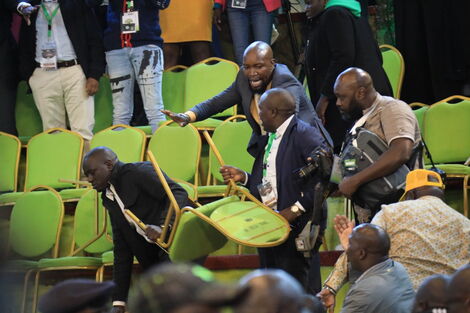
Chaos at Bomas of Kenya on Monday, August 15, 2022, as IEBC chair Wafula Chebukati announced William Ruto as president-elect.
Kenyans.co.ke
“Do you know who has won? Between Ruto and Raila, who is leading? Why have you stopped tallying? Is Chebukati going to declare a winner?” These were among the most asked questions.
At that point, any answer we would have given would have been a recipe for chaos. IEBC’s announcement was the final say. Period!
That night, the chaos at Bomas of Kenya escalates with the two sets of politicians clashing over a controversial gadget. The drama is about to reach its fever pitch, but the nation is still calm.
Monday, August 15
Chebukati says that he will announce the results at 3pm – ‘African time’. We call it African time as the joke claims that Africans never keep time. The announcement is postponed to 5pm and then 6pm.
But before then, in our newsroom, we already have written and edited nearly 15 articles – news to follow-ups and timeless articles.
We are ready for both Raila and Ruto to win and both to lose. The only person delaying us was Chebukati as all articles were ready to be published.
Then the news announcing four IEBC commissioners are to hold a presser at a Nairobi hotel breaks. The editors in the space immediately assign writers to follow up on the developments.
At that time, we published almost 10 articles in 30 minutes, from the Juliana Cherera presser to Azimio La Umoja refuting the results, Chebukati being assaulted at the Bomas of Kenya, Ruto leaving the national tallying centre and Raila being awol, to Ruto walking back and Bomas and Chebukati declaring him the president-elect.
Ruto then holds a media briefing where he rules out a handshake with Raila, details how he would run the government and his sour relationship with President Uhuru Kenyatta.
Our shifts have ended, but then congratulatory messages are streaming in from world leaders and we all agree to sit past 11 pm. Hours prior to that agreement, the whole newsroom nearly turned against HR after announcing that we would work extra days and proceed on our off-days on Wednesday and Thursday.
The thought of working nearly 9 to 11 days running… It was a tense newsroom. The exhaustion, the adrenalin, the anxiety… But HR got it covered as the extra days were to be compensated. Sometimes in life, you ought to push way above the limit.
“We had planned to give Kenyans a 360° coverage and I am so happy that we achieved our targets,” Adongo Kyalo, a social manager says.
“Election coverage was a marathon. It was demanding both physically and mentally and I am glad we were able to give Kenyans timely information and coverage,” Washington Mito, a senior writer adds.
The next day, we are back to the core of the drama, with Azimio La Umoja’s Raila refuting the election results to Juliana Cherera detailing her confrontation with Chebukati.
We all thought the drama would be over, but then Raila announces that he will seek legal redress at the Supreme Court. Another 14 days of covering the election petition and maybe 60 days of campaigns in case the apex court nullifies the 2022 General Election.
Everyone slumps into their chairs.
“Being my first time covering elections, I felt overwhelmed but with support from other team members, I acclimatised and delivered as expected. With that experience and exposure, I’m even ready to cover the presidential petition when it will be filed,” Lutta Njomo says.
“When the elections began, we were already anticipating chaos in the newsroom but we were hit with the exhilarating kind. The late nights and early mornings were tough but if this is the chaos I have to live with, then I am in love,” senior writer, Derrick Okubasu adds.
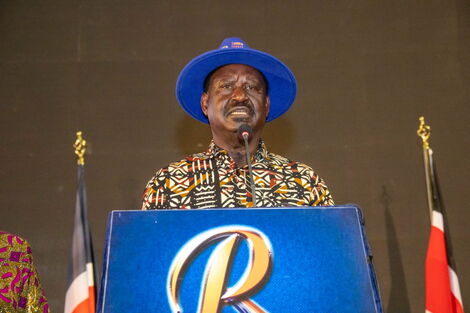
Raila Odinga addresses the media at KICC on Tuesday, August 16, 2022
Kenyans.co.ke


















Discussion about this post